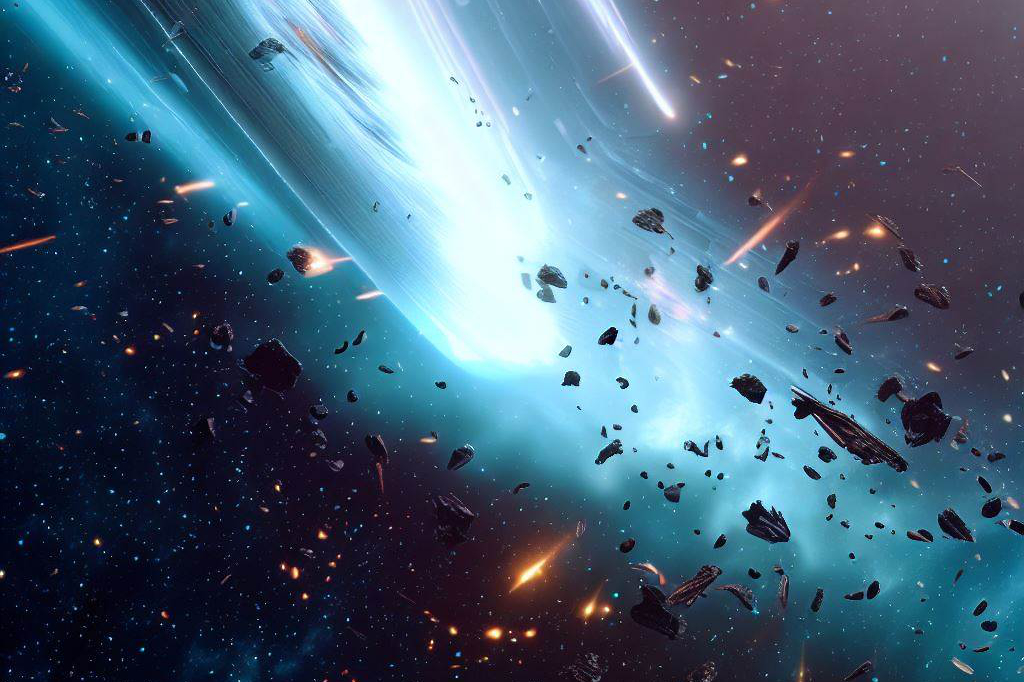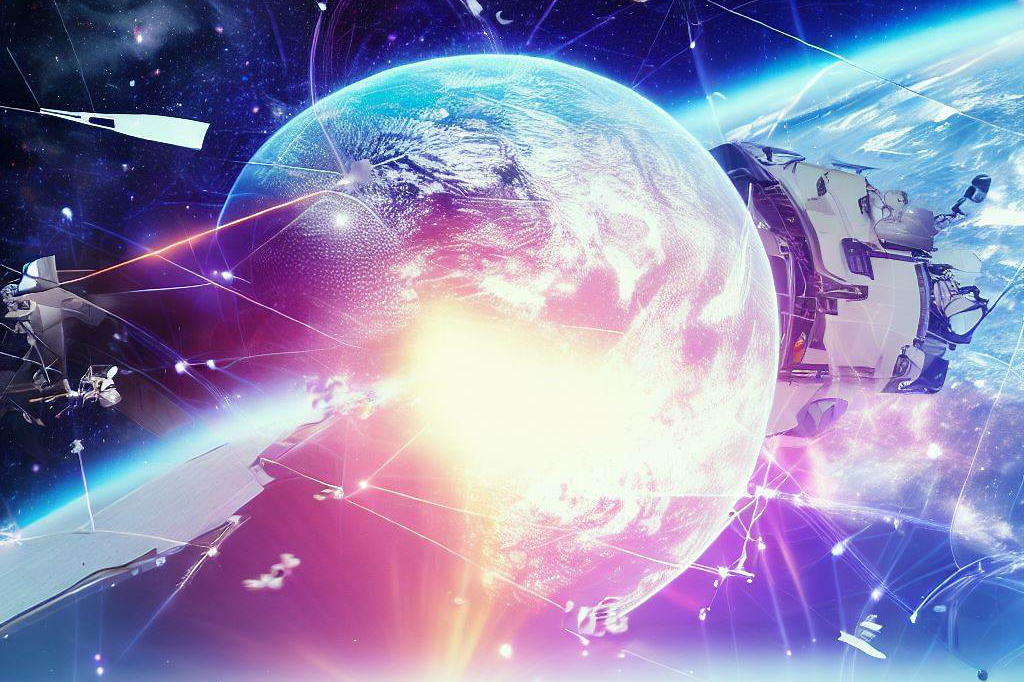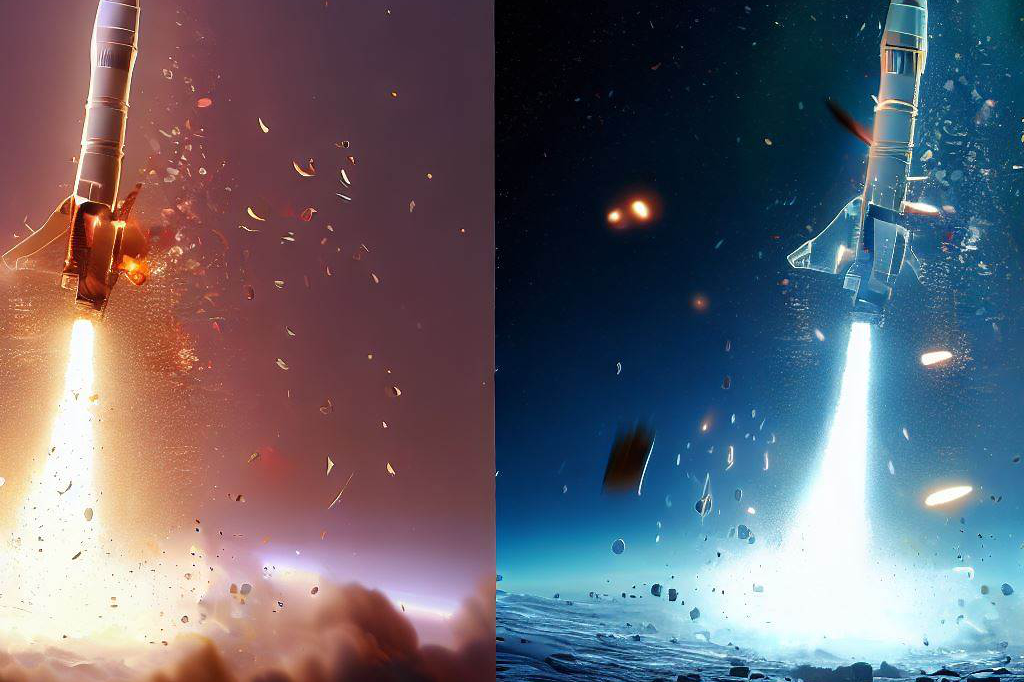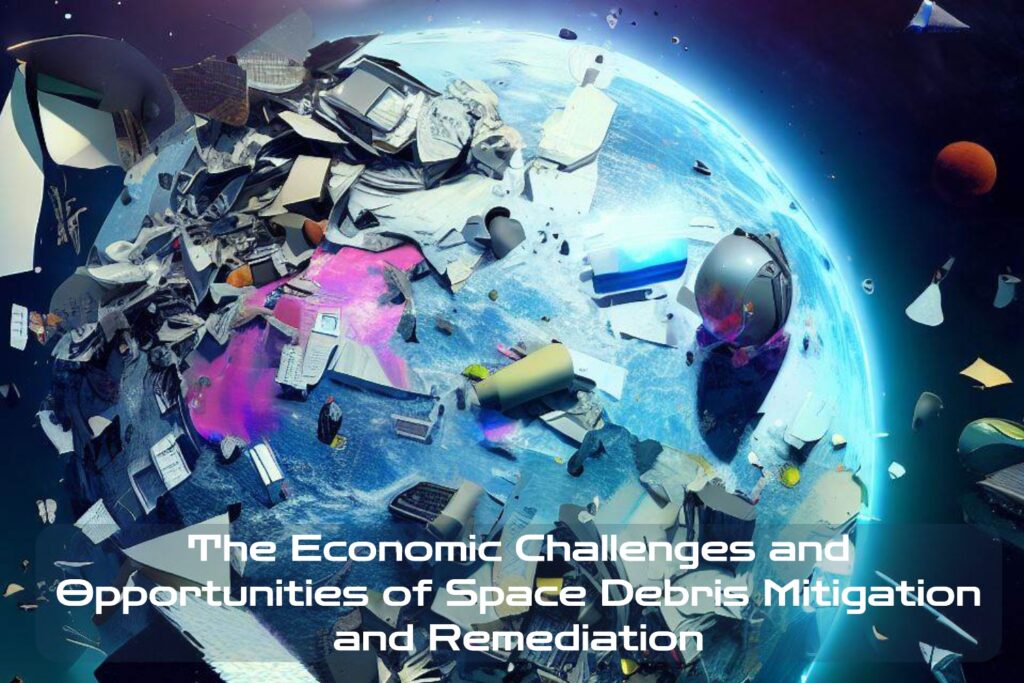Brief Explanation of Space Debris and Its Impact on Space Exploration
Space debris, or orbital debris, refers to man-made objects that are orbiting the Earth, but no longer serve any useful purpose. These objects can range from fragments of satellites and rocket parts, to lost astronaut tools and even paint chips.
While they may seem harmless, these debris pose serious threats to space exploration activities. The risks of space debris include collisions with active satellites and spacecraft, which can cause damage or even total loss.

Additionally, the debris orbiting the Earth can also cause chain reactions when they collide with each other – this phenomenon is known as the Kessler Syndrome. In this scenario, the collision creates more space debris, which in turn causes more collisions, leading to a cascading effect that makes it difficult for spacecraft to enter or exit Earth’s orbit.
Importance of Addressing the Issue of Space Debris Mitigation and Remediation

The issue of space debris mitigation and remediation has become increasingly important in recent years due to the exponential growth of human-made objects in space. With thousands of functioning satellites currently in orbit, it is important to find ways to prevent the further production of unnecessary debris before they turn into dangerous obstacles.
Several international organizations, such as NASA, ESA, JAXA are responsible for managing orbital debris programs aimed at mitigating the risks associated with it. However, given the complexities involved in managing orbital debris coupled with funding challenges, there is still much work to be done.
We cannot afford to neglect the problem posed by space junk if we truly desire long-term sustainability in our endeavours in outer-space exploration. The need for continued research into cost-effective mitigation technologies cannot be over-emphasized as we aim to achieve safe and secure operations in outer-space activities.
The Economic Challenges of Space Debris Mitigation and Remediation
Cost of Developing and Implementing Mitigation Technologies

One of the most significant economic challenges for space debris mitigation and remediation is the cost of developing and implementing new technologies. Space debris removal technologies are still relatively new, and research in this field continues to be expensive.
The development of these technologies requires advanced engineering techniques, specialized materials, and sophisticated systems, which often result in high costs. The implementation of these technologies also requires significant investments.
For example, many active debris removal (ADR) systems require the launch of a separate spacecraft that performs the debris removal operation. This can significantly increase the cost of a satellite mission to include ADR capabilities.
Liability Issues for Satellite Operators and Launch Providers
Another economic challenge in space debris mitigation is the liability issue faced by satellite operators and launch providers. In addition to being responsible for removing their own spacecraft after it has lived out its usefulness or become non-functional, they may be held accountable for any damage caused by their spacecraft or associated space debris.
Liability issues are particularly complicated when more than one organization contributes to creating space debris, making it challenging to attribute responsibility accurately. Furthermore, as new players enter the commercial space industry, it’s unclear how liability will be distributed among different actors.
Funding Challenges for Government Agencies Responsible for Space Debris Management
Government agencies such as NASA or ESA are generally responsible for managing space activities such as launches from their territory while maintaining orbits free from collision risks due to space debris. However, funding challenges remain an issue in adequately funding such activities. Spacecraft tracking systems need upgrades that can track smaller objects with greater accuracy; hence, upgrades can cost millions per year just to maintain current tracking capabilities.
Also, developing new technology acquisition projects involving international collaborations requires time-consuming negotiations on budget allocations between the governments involved, which can often delay the project itself. As more private entities enter the space industry, it remains unclear how governments will divide funding between public and private organizations for space debris mitigation activities.
The Opportunities in Space Debris Mitigation and Remediation
Development of New Technologies to Remove or Mitigate Space Debris

One of the most exciting opportunities in space debris mitigation and remediation is the development of new technologies to remove or mitigate space debris. There are many ideas being explored, from nets and harpoons to lasers and ion thrusters.
Some companies are even experimenting with space-based “vacuum cleaners” that would use suction to capture small pieces of debris. One technology that has received a lot of attention is Active Debris Removal (ADR).
This involves sending a spacecraft into space to actively capture and remove larger pieces of debris. ADR has the potential to significantly reduce the amount of space debris in orbit, making it safer for future space missions.
Creation of New Industries Focused on Space Debris Removal Services
Another opportunity arising from the need for space debris mitigation and remediation is the creation of new industries focused on providing these services. As more countries and private companies launch satellites into orbit, there will be an increasing demand for companies that can safely remove those satellites once they reach the end of their useful life.
This presents an opportunity for entrepreneurs who are interested in starting their own businesses focused on this growing industry. There may also be job opportunities in existing aerospace companies as they expand their capabilities to include space debris removal services.
Potential for International Collaboration on Space Debris Management

Another opportunity arising from the need for space debris mitigation and remediation is increased international collaboration on this important issue. Space debris affects everyone who relies on satellites for communication, navigation, weather monitoring, and other essential services.
As such, there is a growing recognition that managing this issue requires cooperation between governments, private industry, academia, and other stakeholders around the world. By working together, we can develop more effective and efficient solutions to the problem of space debris, ensuring the safety and sustainability of space for generations to come.
Active Debris Removal (ADR)
Space debris are objects in orbit around Earth that no longer serve any useful purpose. They pose a threat to current and future space missions, and their accumulation can lead to a dangerous situation known as the Kessler Syndrome. Active Debris Removal (ADR) refers to the use of spacecraft or other devices to physically capture or manipulate these objects, either by pushing them out of orbit or returning them to Earth’s atmosphere, where they can burn up.
One example of ADR technology is the RemoveDebris mission led by the University of Surrey in the United Kingdom. The mission involves deploying a satellite equipped with a net and harpoon system to capture and remove debris from orbit.
Another ADR technology is Electrodynamic Tethers (EDTs), which use long wires that extend from a satellite to interact with Earth’s magnetic field, allowing it to slow down and drag debris out of orbit.
There are pros and cons associated with ADR technology.
On the one hand, it offers an effective way to remove large items from orbit quickly. On the other hand, it can be costly and complex since capturing individual pieces requires careful planning and precise execution.
Passive Debris Removal (PDR)
Passive Debris Removal (PDR) technologies work by reducing the amount of space debris generated in the first place rather than actively removing existing debris. PDR technologies include designing satellites for more controlled re-entry so they burn up completely on re-entry into the earth’s atmosphere rather than leaving fragments behind; using materials that do not produce as much debris when they break apart; or moving satellites further away from each other so there is less risk of collisions.
One example of PDR technology is NASA’s Safe Escape System, which allows satellites that encounter mechanical failures during launch or early operation stages to safely de-orbit without creating additional space junk in earth’s orbit. Another PDR technology is designing satellites to be able to reposition themselves in orbit, which can help them avoid collisions with other objects.
While PDR technology does not offer an immediate solution to the problem of existing space debris, it has the potential to significantly reduce future debris accumulation. One major advantage of PDR is that it can be less expensive and complex than ADR since it does not require advanced capture or manipulation technologies.
Other Mitigation Technologies
In addition to ADR and PDR technologies, there are a number of other methods being explored for mitigating space debris. Tether systems use long wires or cables attached to a satellite in order to pull debris out of orbit. Laser ablation involves using high-powered lasers to vaporize small pieces of debris, causing them to lose altitude and eventually burn up in the Earth’s atmosphere.
Another method under development is electrodynamic tethers, which generate an electromagnetic field that interacts with Earth’s magnetic field in order to create drag that pulls the satellite down into lower orbits, where it will eventually burn up upon re-entry. Each mitigation technology has its own set of advantages and challenges.
While tether systems are relatively simple and cheap compared to more complex ADR technologies, they may struggle with capturing small or irregularly shaped objects. Laser ablation is effective at removing small pieces but requires precise targeting and can potentially create additional space debris if not managed properly.
Overall, there are many promising technologies being developed for addressing the issue of space debris mitigation and remediation. By working together, governments, industry leaders, and researchers can help ensure a safe and sustainable future for space exploration.
Subtopics on the Economic Impact of Space Debris Mitigation and Remediation

Cost Analysis
When it comes to space debris mitigation and remediation, one of the biggest concerns is the cost. The development and implementation of mitigation technologies can be quite expensive, which presents a challenge for satellite operators and launch providers.
In addition, liability issues can arise if a satellite or spacecraft collides with space debris. This means that there may be additional costs associated with insurance policies or legal fees.
However, despite these challenges, there are also potential economic benefits to investing in space debris mitigation and remediation technologies. For example, by reducing the amount of space debris in orbit, we can increase the safety and reliability of space missions.
This can lead to more successful launches and a reduction in costly accidents. Additionally, by developing new technologies for removing or mitigating space debris, we are creating new industries that have the potential to create jobs and stimulate economic growth.
Cost-benefit analysis for implementing mitigation technologies
To determine whether or not it is worth investing in space debris mitigation and remediation technologies, it is important to conduct a cost-benefit analysis. This involves weighing the costs associated with developing and implementing these technologies against the potential benefits they may provide.
One way to approach this analysis is to consider the potential costs of not investing in these technologies. For example, if a satellite were to collide with space debris due to lack of adequate mitigation measures, it could result in millions or even billions of dollars in damages.
By contrast, investing in mitigation measures may require an upfront cost but could ultimately save money by preventing such accidents. Another factor that should be considered is the long-term economic impact of reducing space debris levels.
By making outer space safer for spacecraft and satellites, we are ensuring that our reliance on these technologies can continue into the future without fear of disruption. This can have a positive impact on various industries that rely on space-based communications and navigation systems, such as shipping and air travel.
Final Thoughts

While the economic challenges of space debris mitigation and remediation are significant, there are also potential benefits to investing in these technologies. By reducing the amount of space debris in orbit, we can increase safety for spacecraft and satellites and stimulate economic growth through the development of new industries.
A cost-benefit analysis can help us determine whether or not investing in these technologies is worth the upfront costs. Overall, by addressing this issue now, we can ensure the long-term sustainability of our reliance on space-based technologies.
FAQs
1. What is space debris, and why is it a concern for space exploration?
– Space debris refers to man-made objects in orbit around the Earth that no longer serve any useful purpose.
– It includes fragments of satellites, rocket parts, lost astronaut tools, and even paint chips.
– Space debris poses a significant threat to space exploration as it can collide with active satellites and spacecraft, causing damage or loss.
2. What is the Kessler Syndrome, and why is it a concern?
– The Kessler Syndrome is a phenomenon where collisions between space debris create more debris, leading to a cascading effect.
– This continuous chain reaction of collisions makes it challenging for spacecraft to enter or exit Earth’s orbit.
– The Kessler Syndrome poses a serious threat to future space missions and the sustainability of outer-space activities.
3. Why is it important to address the issue of space debris mitigation and remediation?
– The exponential growth of human-made objects in space has made space debris mitigation crucial.
– Thousands of functioning satellites currently orbit the Earth, and preventing the production of unnecessary debris is essential.
– International organizations like NASA, ESA, and JAXA are responsible for managing orbital debris programs, but more work needs to be done.
4. What are the economic challenges of space debris mitigation and remediation?
– The development and implementation of mitigation technologies are costly due to advanced engineering techniques and specialized materials.
– Liability issues arise for satellite operators and launch providers, as they may be held accountable for damage caused by their spacecraft or associated debris.
– Government agencies responsible for space debris management face funding challenges in adequately funding tracking systems and new technology acquisition projects.
5. What opportunities arise from space debris mitigation and remediation?
– The development of new technologies, such as active debris removal (ADR), provides opportunities to remove or mitigate space debris.
– New industries focused on space debris removal services can emerge, creating job opportunities and economic growth.
– Increased international collaboration is another opportunity to address the issue collectively and develop effective solutions.
TL;DR …
– 🚀 Space debris refers to man-made objects in orbit around the Earth that no longer serve any useful purpose and pose serious threats to space exploration.
– 🌍 The Kessler Syndrome is a phenomenon where collisions between space debris create more debris, making it difficult for spacecraft to enter or exit Earth’s orbit.
– 🌌 Space debris mitigation and remediation have become increasingly important due to the exponential growth of human-made objects in space.
– 🛰️ The economic challenges include the high cost of developing and implementing mitigation technologies and liability issues faced by satellite operators and launch providers.
– 💡 Opportunities in space debris mitigation include the development of new technologies for debris removal, the creation of new industries focused on space debris removal services, and increased international collaboration.
– 💰 A cost-benefit analysis is important to determine the economic viability of investing in space debris mitigation technologies.
– 🌐 Addressing space debris is crucial for the long-term sustainability of space-based technologies and industries.
– 📊 By reducing space debris levels, we can increase safety, prevent costly accidents, and stimulate economic growth in various industries that rely on space-based systems.

C M, a seasoned editor, journalist, and consultant, is deeply fascinated by the convergence of technology, space, and the future of humanity.
With a particular interest in transhumanity, futurology, and the philosophical and ethical dimensions of these domains, C M serves as the lead contributor to SpaceSpotlight and TranscendSphere.
When not penning insightful articles on these rapidly evolving fields, C M indulges in their love for podcasts and books, proudly embracing their status as a ‘Happy Nerd Extraordinaire!’



